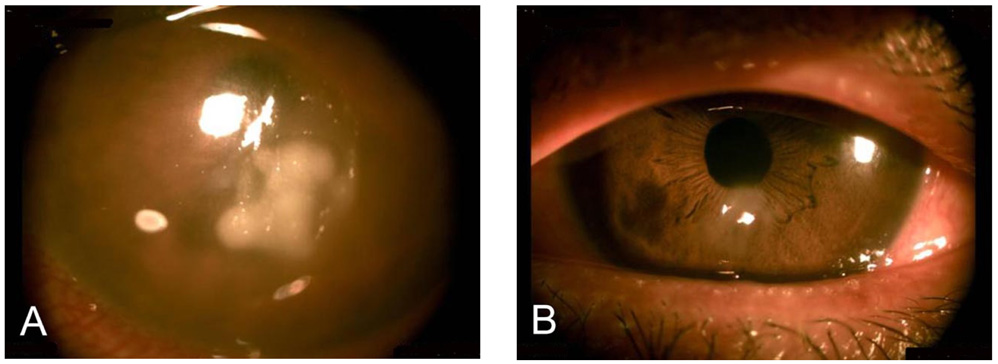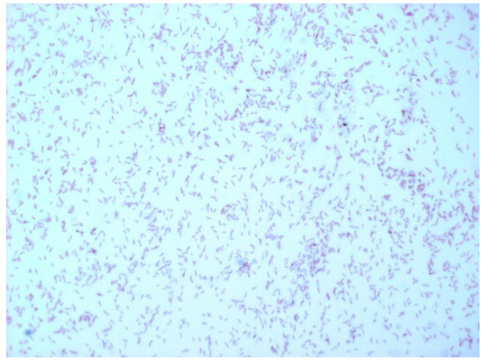Korean J Ophthalmol.
2005 Sep;19(3):233-234. 10.3341/kjo.2005.19.3.233.
A Case of Epidemic Keratoconjunctivitis Complicated by Alcaligenes Xylosoxidans Infection
- Affiliations
-
- 1Department of Ophthalmology, Seoul National University College of Medicine, Seoul, Korea. wrwee@snu.ac.kr
- 2Seoul Artificial Eye Center, Seoul National University Hospital Clinical Research Institute, Seoul, Korea.
- 3Seoul National University Bundang Hospital, Seongnam, Gyeonggi-do, Korea.
- KMID: 754430
- DOI: http://doi.org/10.3341/kjo.2005.19.3.233
Abstract
- PURPOSE
To report a case of epidemic keratoconjunctivitis complicated by Alcaligenes xylosoxidans. METHODS: A 37-year-old man suffered epidemic keratoconjunctivitis in both eyes. Eleven days later, he developed a corneal ulcer in his left eye. Bacterial staining, culture, and antibiotics sensitivity test were performed from a corneal scrape. RESULTS: The cultures revealed a growth of Alcaligenes xylosoxidans, and the patient was treated with ceftazidime and levofloxacin, based on the sensitivity test results. After 21 days of treatment, the infection was resolved with mild scaring and final vision in the left eye of 20/20. CONCLUSIONS: Alcaligenes xylosoxidans should be considered a rare but potential pathogen able to produce corneal ulcer complication in epidemic keratoconjunctivitis.
Keyword
MeSH Terms
Figure
Cited by 3 articles
-
Causes of epidemic keratoconjunctivitis and therapeutic measures
Jeong Jae Oh, Chang Rae Rho
J Korean Med Assoc. 2017;60(6):491-496. doi: 10.5124/jkma.2017.60.6.491.A Case of Alcaligenes xylosoxidans Keratitis in a Soft Contact Lens Wearer
Yang Kyung Cho, Dong Hyun Gi, Hyun Kyung Kim, Tae Yoon La
J Korean Ophthalmol Soc. 2010;51(11):1525-1527. doi: 10.3341/jkos.2010.51.11.1525.A Case of Chronic Dacryocystitis Caused by Achromobacter Xylosoxidans
Che Ron Kim, Gyu Nam Kim, Kyeong Hyeon Kim, Ji Myong Yoo, Seong Wook Seo
J Korean Ophthalmol Soc. 2011;52(8):979-983. doi: 10.3341/jkos.2011.52.8.979.
Reference
-
1. Holmes B, Snell JJ, Lapage SP. Strains of Achromobacter xylosoxidans from clinical material. J Clin Pathol. 1977. 30:595–601.2. Newman PE, Hider P, Waring GO III, et al. Corneal ulcer due to Achromobacter xylosoxidans. Br J Ophthalmol. 1984. 68:472–474.3. Pan TH, Heidemann DG, Dunn SP, et al. Delayed onset and recurrent Alcaligenes xylosoxidans keratitis. Cornea. 2000. 19:243–245.4. Fiscella R, Noth J. Achromobacter xylosoxidans corneal ulcer in a therapeutic soft contact lens wearer. Cornea. 1989. 8:267–269.5. Siganos DS, Tselentis IG, Papatzanaki ME, et al. Achromobacter xylosoxidans keratitis following penetrating keratoplasty. Refract Corneal Surg. 1993. 9:71–73.
- Full Text Links
- Actions
-
Cited
- CITED
-
- Close
- Share
- Similar articles
-
- A Case of Alcaligenes xylosoxidans Endophthalmitis after Cataract Extraction
- A Skin Ulceration Complicated by Alcaligenes Xylosoxidans Infection
- A Case of Alcaligenes xylosoxidans Keratitis in a Soft Contact Lens Wearer
- A Pseudoepidemic of Alcaligenes xylosoxidans Due to Contaminated Buffer Solution
- A Case of Peritonitis Due to Achromobacter xylosoxidans subsp. xylosoxidans in a Patient Undergoing Continuous Ambulatory Peritoneal Dialysis (CAPD)



